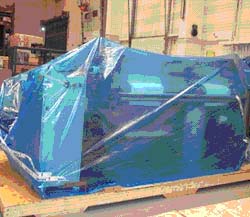|
| Welcome to MPPL |
Packaging is a part of everyday life. It provides adequate protection to the stored material, creates brand image & acts as a 'Silent Advertiser' for the products.
MATHURA POLY PACK P LTD, established in 1992, is an ISO 9001 company.
We are manufacturer & exporters offering Flexible Packaging Solutions to match the needs of clients. We have established ourselves in the industry on the basis of quality & innovation. |
| more info... |
|
|
|
| |
|
|
|
|
VCI Films & products |
|
| MPPL- VCI Films / (VCI-Corrosion Protection Film) |
Characteristics
MPPL VCI is a transparent, bluish special polyethylene film; it is nitrite- and amine-free and features active VCI corrosion protection on both sides. It is waterproof, weldable and suitable for use in automated packaging processes and for bag manufacturing. The film continually releases small amounts of active substances into the atmosphere inside the packaging, meaning that metal surfaces that are not directly in contact with the film also benefit from protection. The distance between film and the surrounding metal surfaces will depend on the packaging volume and the amount of time needed for a protective atmosphere to build up - 10 cm can be used as a rule of thumb. Depending on the packaging volume, it can take up to 20 hours for a sufficient protective atmosphere to dev |
Scope of protection
Steel, cast iron (limited, only on contact); reliable corrosion protection for galvanized steel, nickel, aluminium, chrome, zinc, and copper and its alloys. We recommend a compatibility test for cadmium and magnesium alloys. |
Film quality
|  MPPL VCI 3.06 MPPL VCI 3.06 | Thickness: 60 µm |  MPPL VCI 3.08 MPPL VCI 3.08 | Thickness: 80 µm |  MPPL VCI 3.10 MPPL VCI 3.10 | Thickness: 100 µm |  MPPL VCI 3.15 MPPL VCI 3.15 | Thickness: 150 µm |  MPPL VCI 3.20 MPPL VCI 3.20 | Thickness: 200 µm | Extra strong:
 MPPL VCI 3.10 XS,Thickness: 100 µm MPPL VCI 3.10 XS,Thickness: 100 µm |
| | | Available product sizes
Flat film, sheets, bags, covers, tubes, half-tubes and side-fold tubes. | | | Work safety
MPPL VCI is not a hazardous formulation as defined in the hazardous materials ordinance. Further information can be found in our Material Safety Data Sheet. | | | | MPPL VCI products are to be used exclusively for the stipulated applications (packaging/preservation of metal parts susceptible to damage). We accept no liability for consequential damage resulting from improper use. | | |
VCI-Principle VCI means Volatile Corrosion Inhibitor, in other words a volatile prevention of corrosion or anticorrosive. The term VCI inhibitor is understood to mean the working of special volatile linkages into differing carrier materials. Inherent inhibitor vapour pressure causes them to evaporate out of the carrier material and to diffuse within the packaging. They are absorbed onto metal surfaces in the form of an invisible film. Once there, they provide active protection against the breakdown of the passive layer. |
Three mechanisms are discussed for corrosion protection:
| Applications
Sea Worthy Corrosion Protection during Shipments
Corrosion Protection during Storage
 |
VCI ZIPPER BAG
| MPPL VCI Storage Guidelines How are VCI products stored?
What should be taken into account when packaging materials?
In order to prevent active-agent loss, products should be stored in a cool, dry place and in their original packaging. Packaging already opened should be sealed wherever possible following work. The top sheet or outer roll should be disposed of following extended storage periods. | | | | |
For any specific queries, contact MPPL Office. |
| |
|
|
|
|